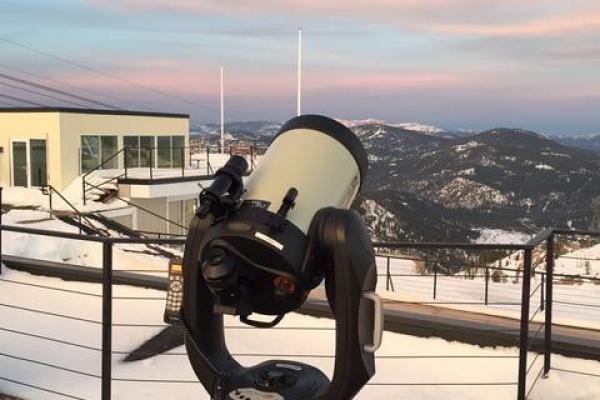What's Up? - Ohio Skylights January 2024

Constellations, Planets, and Astronomical Events Visible in January 2024
Happy New Year! Along with the new year, the days will start to grow longer again since the winter solstice is behind us. This month, the sun will rise near 7:52 am, and set around 5:30 pm; therefore, the average amount of daylight is around 9 hours and 37 minutes, and every day we gain approximately 1 minute and 30 seconds of daylight. The new moon occurs on January 11th. With the long nights and dark skies, this will be the best time to stargaze. The full moon rises on January 25th; this moon was nicknamed the Wolf Moon for the wolf packs that travel near Native American camps.
The Quadrantids meteor shower occurs this month. This meteor shower runs annually from January 1st through 5th as the Earth passes through the remnants of an extinct comet called 2003 EH1. This year, the shower peaks the early morning of January 4th at an impressive 40 meteors per hour radiating from the constellation Boötes. The constellation will rise on the northeastern horizon near 12:30 am, so the best viewing won’t be until after 2 am. The moon will be in its waning gibbous phase, so many faint meteors will be obscured. However, good weather and patience will reward an observer with a good show.
Mercury achieves its greatest western elongation on January 12th. Greatest elongation means that Mercury is at its farthest distance away from the sun (23.5 degrees) from our point of view on Earth. Western elongation means that Mercury is west of the sun, and it will be visible approximately 1 hour and 30 minutes before sunrise on the eastern horizon. Since this is the farthest away Mercury gets from the sun, it is the best time to observe the planet.
Venus is also visible before sunrise above the eastern horizon. Venus is brighter and further away from the sun than Mercury, so it will be more easily visible this month. Mars is nearing the end of its journey behind the Sun, but it is still too difficult to see for the duration of January. It won’t be easily observable again until mid-March.
Jupiter is still easily observable this month; though it continues to set slightly earlier every day. The giant will be almost overhead at sundown, and it sets below the horizon at 2 am. Saturn is approaching its journey behind the Sun; it is just above the western horizon at sunset, and it sets only 3 hours into the evening at 8:40 pm.
Uranus is close behind Jupiter, setting only an hour after it. Uranus can be found by aiming a telescope slightly eastward from Jupiter between the constellations Aries and Taurus; however, the planet is still too faint to observe with the naked eye. Neptune is somewhat close behind Saturn, setting only two hours afterward. Neptune can be found under the westernmost fish in the constellation Pisces, but not without the aid of a telescope.
Ursa Major (The Big Dipper) is one of the most recognizable constellations in the Northern Hemisphere. It never sets below the horizon so it is visible every night at any time of year, which makes it a fantastic constellation to help navigate through the sky. For example, in preparation for this month's meteor shower, the handle of the Big Dipper can help guide the eye to the constellation Boötes. The stars in the Dipper’s handle create an arc in the sky; if you continue the arc away from Ursa, it will lead to the bright star Arcturus in the constellation Boötes. Boötes is only visible after 1 am over the eastern horizon, and it will continue to climb higher in the sky until sunrise.
Happy observing!
Sources:
Image Credits:
Full Moon: https://unsplash.com/photos/a-full-moon-rising-over-a-snowy-mountain-a1BlhTu0lMI Credit: Mateusz Klein
Quadrantids Radiant Point: https://skyandtelescope.org/astronomy-blogs/explore-night-bob-king/venus-farewell-moonless-skies-for-the-quadrantids/
Planetary Position Diagram: https://www.skymarvels.com/infopages/vids/2022MercuryGreatestElongations001.htm
Boötes and Ursa Major: https://stellarium-web.org/
